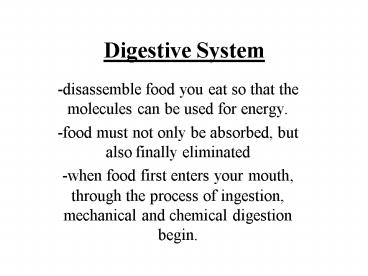Digestive System - PowerPoint PPT Presentation
1 / 9
Title:
Digestive System
Description:
... then diffuse into tiny blood vessels of the villus and enter the bloodstream. The villi are the link between the digestive system and the circulatory system. ... – PowerPoint PPT presentation
Number of Views:34
Avg rating:3.0/5.0
Title: Digestive System
1
Digestive System
- -disassemble food you eat so that the molecules
can be used for energy. - -food must not only be absorbed, but also finally
eliminated - -when food first enters your mouth, through the
process of ingestion, mechanical and chemical
digestion begin.
2
Mouth
- Tongue moves food around and positions it between
your teeth. - Chewing is a form of mechanical digestion
(breaking down food) - Chemical digestion is the process of changing
food on a molecular level through the action of
enzymes. - Chemical dig. Begins in the mouth.
- Your saliva contains an enzyme called amylase,
which breaks down starch into smaller molecules
such as mono or disaccharides. Amylase continues
to work in the stomach for about 30 mins.
3
Esophagus
- After chewing, your tongue shapes your food into
a ball and move it to the back of your mouth to
be swallowed. - As you swallow, a cartilage flap (epiglottis)
covers your trachea (windpipe) so that you dont
choke. down the wrong pipe. - Swallowing forces food into your esophagus a
muscular tube that connects your mouth to your
stomach. - Food moves down the esophagus by means of
peristalsis a series of involuntary smooth
muscle contractions.
4
Stomach
- After swallowing, food enters the stomach
- It is a muscular, pouchlike structure
- Both mechanical and chemical digestion take place
here - Mechanical- actually muscles churn food.
- Chemical the stomach secretes gastric juices
containing pepsin (works on proteins) and HCl
(provides an acidic env. Which pepsin likes). - pH about 2 (a thick mucus lining protects it form
the acid) - Food remains there about 3-4 hrs.
5
Small intestine
- When food is ready to leave the stomach, it has
the consistency of tomato soup. Peristaltic
waves begin to push it into the SI, which is
about 6 meters long and has 3 distinct parts. - Digestion of your meal is completed here.
- Muscular contractions continue to break down
food. - Carbs and proteins are broken down with the help
of enzymes produced by the liver and pancreas. - These enzymes from the liver, pancreas and gall
bladder enter the SI through ducts. - These organs are important even though food does
not pass through them.
6
Pancreas
- Secretes both digestive enzymes and hormones
- The enzymes it secretes breaks down carbs,
proteins and fats. - It also helps to neutralize the acidity of the
liquid food, stopping any further action of pepsin
7
Liver
- Very large, complex organ with many fxns.
- Produces bile (breaks down fats)
- Bile is stored in the gall bladder.
8
Absorption of Food
- Liquid stays in your SI for 3-5 hrs. and is moved
slowly via peristalsis - As it moves it passes by 1000s of tiny fingerlike
projections called villi (they greatly increase
surface area) - Villi absorb digested food molecules which then
diffuse into tiny blood vessels of the villus and
enter the bloodstream. - The villi are the link between the digestive
system and the circulatory system.
9
The Large Intestine
- Indigestible material form your meal now passes
into your LI, a muscular tube that is also called
the colon. It is much shorter than the SI, but
it has a larger diameter. - The LI is greatly responsible for water and salt
absorption, leaving behind solid waste. - It is also resp. for vit. synthesis. Anaerobic
bacteria in the LI synthesize some B vits. And
vit. K, which are absorbed as needed by the body.

